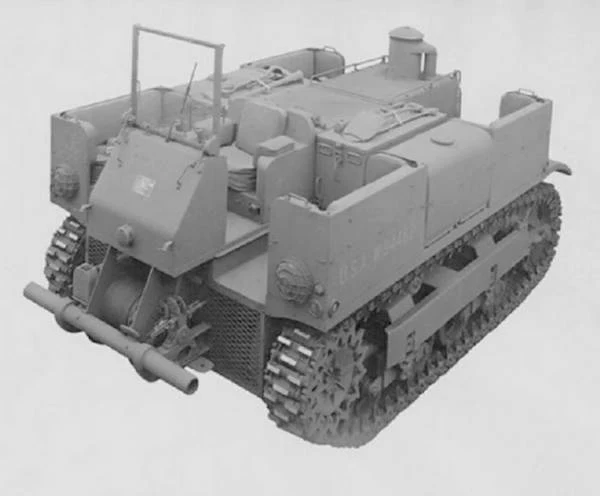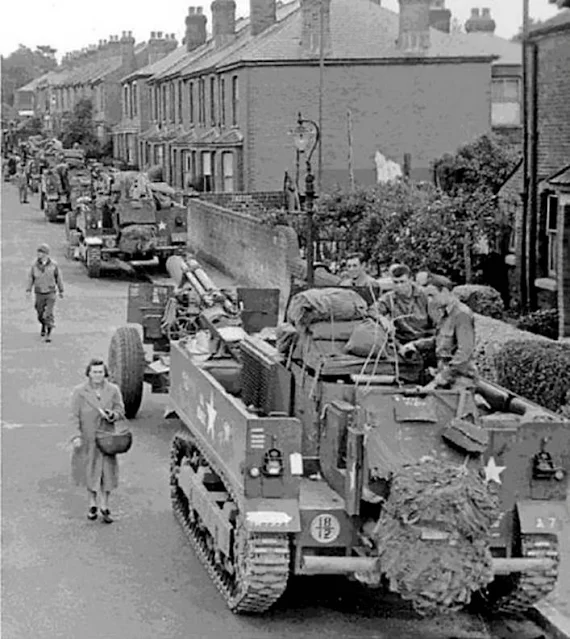 |
| Medium Tank M2, 1939. |
The Medium Tank M2 was a United States Army tank that was
first produced in 1939 by the Rock Island Arsenal, just prior to the
commencement of the war in Europe. Production was 18 M2 tanks, and 94 slightly
improved M2A1 tanks, for a total figure of 112. Events in Western Europe
rapidly demonstrated that the M2 was obsolete, and it was never used overseas
in combat; it was, however, used for training purposes throughout the war.
The M2's unique features included an unusually large number
of machine guns, bullet deflector plates, and sloped armor on the hull front
(glacis plate). The main armament was a 37 mm (1.5 in) gun, with 32 mm (1.3 in)
armor; the M2A1 had a 51 mm (2.0 in) gun mantlet. The features of the M2 series
development, both good and bad, provided many lessons for U.S. tank designers
that were later applied with great success in the M3 Lee, M4 Sherman and many
other armored fighting vehicles.
Rock Island Arsenal started work on a new medium tank, based
on the design of the M2 Light Tank. Initially designated the T5, the redesigned
model (with a 350 hp R-975 radial engine) was re-designated as the M2 Medium
Tank in June, 1939. After the first 18 units had been produced at Rock Island
Arsenal and evaluated by the army, the upgraded M2A1 specification was approved
with a redesigned turret and a more powerful engine.
The medium tank M2 was a larger development of the M2 Light
Tank. Many components were common or used a similar design, including the
vertical volute spring suspension which would be used in later tanks as well.
Twin-wheeled bogies were mounted externally, and rubber-bushed and rubber-shod
track proved durable on roads. The initial M2 model was powered by an air-cooled
Wright R-975 radial engine. For the M2A1, this engine was supercharged to
provide an extra 50 hp (37 kW) for a total of 400 horsepower (300 kW), and
designated as the R-975 C1 radial engine.
The M2 had a high superstructure, with a sponson-mounted
machine gun in each corner. In addition, two more machine guns were fixed in
the glacis plate and fired by the driver. Surmounting the superstructure was a
small revolving turret armed with a 37 mm Gun M3 and a coaxial machine gun. The
37 mm gun could penetrate 46 mm of face-hardened armor sloped 30° at a range of
500 yards (457 meters), and 40 mm at 1,000 yards (914 meters). This armament
configuration was a hybrid between the sponson-mounted weapons of the Mark VIII
Liberty tank of World War I vintage, and the combination of turreted cannon,
coaxial machine gun and glacis-mounted machine gun that was almost universal in
World War II medium tanks. (Two additional .30-caliber machine guns could be
mounted on pintles on either side of the turret for anti-aircraft use, bringing
the total to nine—surely a record for any tank brought into service by any
army.) The crew consisted of the tank commander, a driver and four gunners. The
vehicle provided internal stowage for 200 rounds of 37 mm ammunition and up to
12,250 rounds of .30-caliber.
Bullet deflector plates were installed over the rear
fenders. The idea behind these plates was that the tank could drive over a
trench, and the rear sponson machine guns could then fire onto the plates; the
bullets would deflect into the trench or the area directly behind the tank.
Like the sponson machine guns themselves, the deflector plates turned out to be
useless in modern warfare, since shooting at enemy troops in open trenches as a
tank passed directly over proved to be a fairly unusual occurrence and a
distinctly secondary manifestation of tank capabilities, with most engagements
occurring at longer ranges.
Chrysler was appointed to manage a new tank plant, the
Detroit Arsenal Tank Plant, to manufacture the M2, and the US Government
contracted in August 1940 for 1,000 vehicles to be produced. Events in Europe
made it obvious that the M2 was obsolete, and the government modified the
contract two weeks later, before production began. Instead of M2 medium tanks,
the plant would now build 1,000 M3 Grant tanks once they had been designed. In
the interim production of the M2 was given to the Rock Island Arsenal, where 94
M2A1s were built up to August 1941. The M2A1 had slightly better armor and a
slightly larger turret than the original M2, since it had the turret from the
M3 Light Tank, with gun mantlet armor 2 inches (51 mm) thick.
The M2 was already obsolete when it entered service. It
compared poorly with contemporary European tanks, such as the French S-35 and
German Panzer III which could withstand 37 mm (1.5 in) anti-tank guns. The 37
millimeters (1.5 in) main armament of the M2 was equivalent to the 37 mm (1.5
in) the Panzer III, 47 mm (1.9 in) S-35 had more powerful guns. By 1941,
Germany had upgunned the Panzer III with a 50 mm (2.0 in) L/42 gun, and the
Soviets had fielded the vastly superior T-34, with a 76 mm (3.0 in) gun and a
sloped 52 mm (2.0 in) glacis plate. Given this, the M2 was essentially a
stopgap measure until more capable tanks like the M3 Lee and M4 Sherman came
along in 1942-43. Although 18 M2s and 94 M2A1s were produced, the Ordnance
office recommended in January 1942 that they should only be used for training
purposes, and they were never sent overseas to combat areas. The U.S. Army
fielded the M2 and M2A1 with the 67th Infantry Regiment (Medium Tanks) and,
subsequently, the 1st Armored Division's 69th Armored Regiment during intensive
training maneuvers in the United States in 1941, and the M2 design continued to
prove useful in a basic training role for tank crewmen. The trained crewmen
from the 69th Armored were scattered to provide cadres to several new armored
divisions and independent M4 tank battalions, as U.S. armored forces were
rapidly expanded in 1942-44.
For combat the M2 was generally a poor design, with thin
armor, inadequate main armament and a high profile. The four sponson-mounted
machine guns proved to be completely unnecessary and ineffective. But the
design provided a few important lessons that were used for the later M3 and M4
medium tanks. In particular, the M2's sloped frontal hull (glacis plate) was
extremely advanced for a 1939 design — the one bright spot in an otherwise
dismal design — and a sloped glacis plate with substantially heavier armor
would become a permanent feature of U.S. tank design. The next medium tank
would have to match the German Panzer IV's 75 mm (3.0 in) turret gun. Since no
suitable turret had been designed in the US, the Lee was designed first to
mount a 75 mm (3.0 in) gun in the right sponson, which had been tested on an
M2; the experimental vehicle was designated T5E2. The Lee's gun was mounted in
a conventional turret on a modified M3, to produce the first Sherman eight
months after the first Lee.
Specifications
Type: Medium tank
Place of origin:
United States
Manufacturer:
Rock Island Arsenal
Number built: 18
M2s; 94 M2A1s
Variants: M2;
M2A1
Weight: 41,000 lb
(18.7 metric tons)
Length: 5.38 m
(17.7 ft)
Width: 2.59 m (8
ft 6 in)
Height: 2.82 m (9
ft 3 in)
Crew: 6
(commander, driver, 4 gunners)
Armor: M2 6.4–32
mm (0.25–1.26 in); M2A1 6.4–51 mm (0.25–2.01 in)
Main armament: 1×
37 mm Gun M3; 200 rounds
Secondary armament:
7× (maximum 9) .30-06 Browning M1919 machine guns; 12,250 rounds
Engine: Wright
R975 EC2 air-cooled radial gasoline; 400/340 hp (298/253 kW)
Suspension:
Vertical Volute Spring Suspension (VVSS)
Fuel capacity:
473 liters (125 U.S. gal)
Operational range:
210 km (130 mi)
Speed: 42 km/h (26 mph)
 |
| T5 Medium Tank Phase I. |
 |
| T5 Medium Tank Phase III (M2 Pilot). |
 |
| T5E1 Medium Tank. |
 |
| Medium Tank T5E1. |
 |
| Medium Tank T5 Phase 1. |
 |
| M2 medium tanks. |
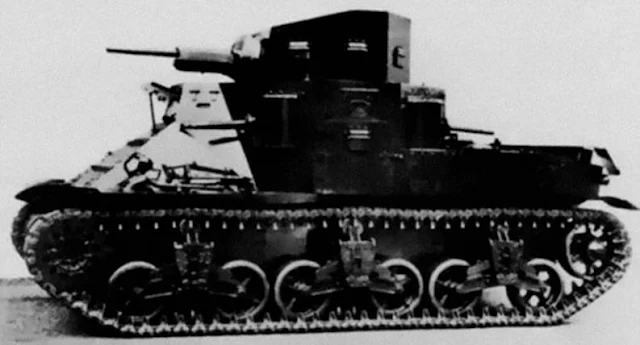 |
| M2A1 Medium Tank. |
 |
| Medium Tank M2A1. |
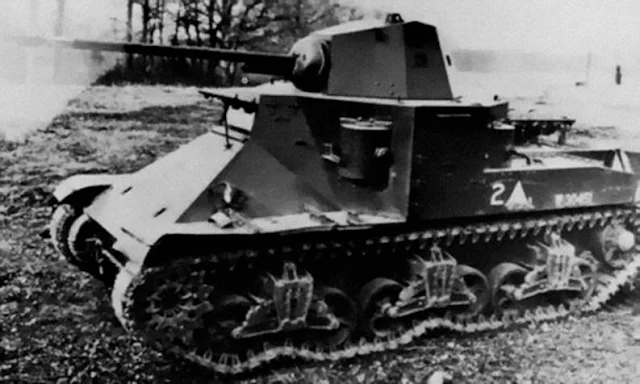 |
| The M2 Medium Tank with E2 Flame Projector was an experimental mounting of the E2 Flamethrower unit upon the M2 Medium Tank. |
 |
| An M2A1 Medium Tank (late production series). |
 |
| The plethora of machine guns arming the Medium Tank M2 is well illustrated here. Each corner of the fighting compartment, each side of the bow, and the sponson roof anti-aircraft mounts all featured a .30 cal machine gun. Bullet deflector plates were installed over the rear fenders. The idea behind these curious additions was that the tank could roll over a trench, and the rear sponson machine guns could then fire onto the plates and the fire would deflect into the trench or the area directly behind the tank. |
 |
| The turret on the M2A1 featured vertical sides to increase working room. The bullet splash deflectors on the hull front slope and rotor shields and sights on the sponson machine guns are also readily visible. The M2 family featured cooling fins on the final drive housings; these were dropped when the medium tank M3 was designed. |
 |
| The T5E2 Medium Tank was the Phase III model reworked, mounting a 75mm Pack Howitzer in the modified right front of the vehicle, with the bow and rear corner machine guns being retained. A small six-sided cupola with rangefinder and machine gun replaced the turret. This was a test vehicle in the development of the Medium Tank M3. |
 |
| T5E2 Medium Tank. |
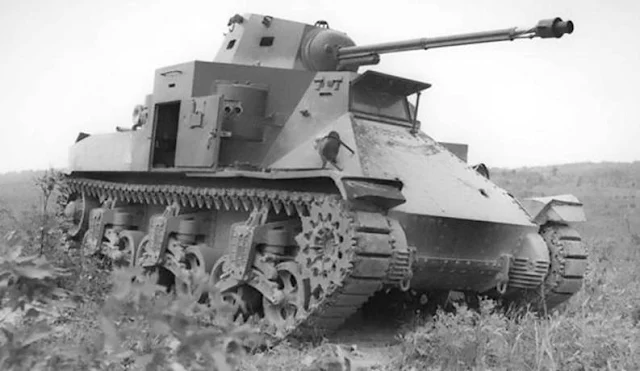 |
| E2 Flame Thrower mounted in the M2 Medium Tank. Note the length of the flame thrower and its vulnerability when moving through wooded areas. Fort Knox, 11 June 1941. |
 |
| Demonstration of M2 Medium Tank with E2 Flame Thrower. |
 |
| M2A1 Medium Tank, 1940. |
 |
| M2A1 Medium Tank (W-30458), 67th Infantry Regiment (Tank), Third Army Maneuvers, 1940. |
 |
| M2A1 Medium Tank during training, Fort Benning, Georgia, February 1940. |
 |
| M2A1 Medium Tank and M3 Medium mock-up. Autumn 1940. |
 |
| M2 medium tank, Aberdeen Proving Ground, Maryland, July 1974. |
 |
| M2 Medium Tank on display at Aberdeen Proving Grounds. |
 |
| M2 Medium Tank, Aberdeen Proving Grounds, 2008. |
 |
| M2A1 Medium on display at the Patton Museum of Cavalry and Armor in Fort Knox, Kentucky, 2007. |
